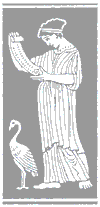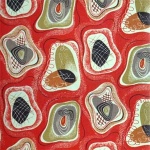 |
|
| Persephone
reads. |
I have come across
a publisher whose catalogue is simply a list of things I have to
read. Persephone Books is a small London-based
publisher that specialises in reprinting the work of “forgotten” writers,
mostly women, which were out of print. Their list includes novels,
short stories and classic cookery books, by writers that, were
it not for Persephone, the twenty-first century might well have
unjustly ignored.
The founder, Nicola Beauman, is also the author of A Very Great
Profession: The Woman’s Novel 1914-1939 and she is someone
who sees the importance of these novels, as do a growing number
of the British public. As Persephone celebrate their fifth birthday
this year, and their fiftieth book is published, their mailing
list has reached 10,000.
In their own words, the name was chosen because:
“...it
has a timeless quality; sounds beautiful; is very obviously
feminine; and symbolises new beginnings (and fertility)
as well as female creativity.
"We did not at first realise that Persephone also symbolises many other
aspects of women's lives, for example, less cheerfully, she represents married
hell (being raped and imprisoned by her uncle Hades).
"But mainly she is an image of women's creativity, and that is why our logo,
based on a painting on a Greek amphora, shows a woman who is not only reading
(the scroll) but also symbolises domesticity (the goose). She is not the goddess
herself, but we preferred her to all other extant images of Persephone as well
as to her own symbols - a daffodil, a lily, a pomegranate and a bat.” |
|

|
Nicola
Beauman, founder.
|
This says more
about Persephone’s aims and ideals than anything
else, and should encourage many male as well as female readers
that these books are well worth a look.
There is a growing awareness that in a culture which celebrates
the quick-selling, celebrity new author, there is a danger that
we will lose sight of excellent works which have been popular with
previous generations. How many of the authors in the catalogue
you will actually have heard of might make this point; some – Noel
Streatfeild, Monica Dickens etc – were writers we remember
from childhood. Others, such as Frances Towers, might be recognised
by short story aficionados, but many, such as Dorothy Whipple and
Marghanita Laski, might have remained unread by this generation
were it not for Persephone. These novels have received the support
of a number of popular contemporary writers such as P D James and
Jacqueline Wilson, who have written prefaces for some of these
books.
 |
|
| Endpapers
for 'Someone at a Distance'. |
There seems
to be a myth that writers of the first half of the last century,
especially women, produced cosy domestic novels based
on the domestic routine of subjugated women. For those of you who
believe this, there are novels that show that while on the surface
this might seem to be true, the reality couldn’t be further
from this myth. The humour and the suffering of humanity is beautifully
placed in the novels and short stories. After all, the twentieth
century was full of amazing events which affected all who lived
and wrote during that time: two world wars, the emancipation of
women, developments in travel, science and philosophy. Women have
a way of looking on and observing events with a wry humour, which
is not to be missed. There are too many for me to go into detail,
but as I read them I will do reviews!
There is one more important aspect of the Persephone experience
to be considered. These are not just books, they are works of art
in themselves. Paperbacks, they have thick plain grey covers which
are a simple delight to the eye and the touch, with the distinctive
Persephone logo. However, they are all furnished with beautiful
fabric-design end papers, bright, varied, and with a matching bookmark,
which is a nice, thoughtful touch. Fabric design is something which
women have always done well, and is something we should celebrate
as a design feature. More significantly, the designs featured always
relate in some way to the book itself – being produced around
the time the book was set or written, or being like a fabric described
in the book, etc. This bonus feature makes the books highly attractive
and ideal presents – but so far I’m keeping mine to
myself! The link between the literary and visual arts is an important
step for book design as a whole, and led to Persephone’s
edition of Joscelyn Playfair’s A House in the Country being
shortlisted for the British Book Design Awards in 2003. Books should
look beautiful, and these really do!
|

|
Award-winning
design on display.
|
So far I have only read five Persephone novels, including 'Tea
With Mr. Rochester' by Frances Towers, 'Consequences'
by E. M. Delafield, and 'Someone at a Distance',
by Dorothy Whipple; I am dying to read more, and hope that this
will whet your appetite for a bit of good
old-fashioned reading. If you want to order books, or a catalogue,
or just marvel at their list, go to their
website.
There is also a Persephone Quarterly magazine, which is free after
you
have placed an order. Also, Persephone is more than just a publisher;
they have monthly literary luncheons in London, and a weekend of
seminars and study at Newnham College, Oxford.
|
|



